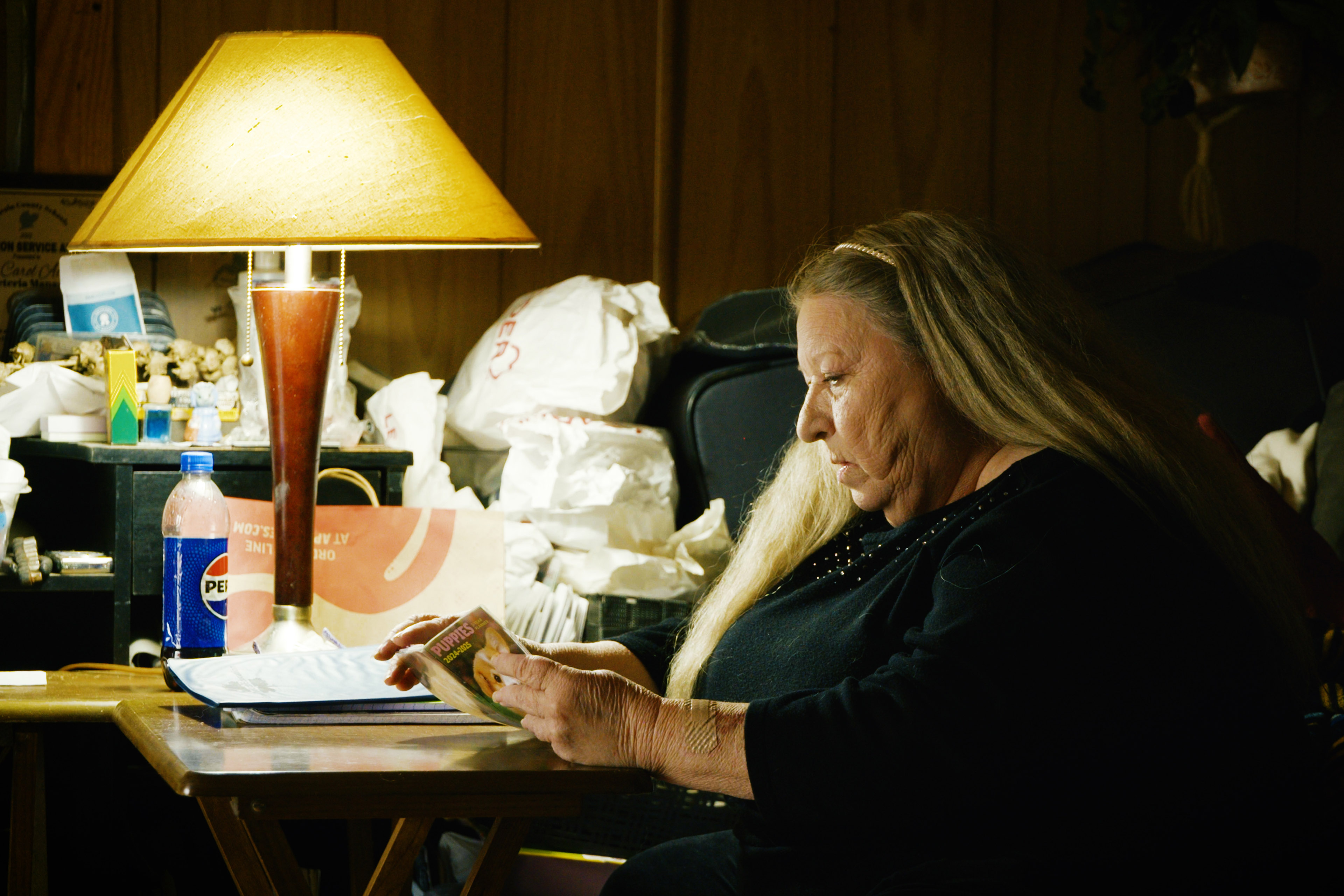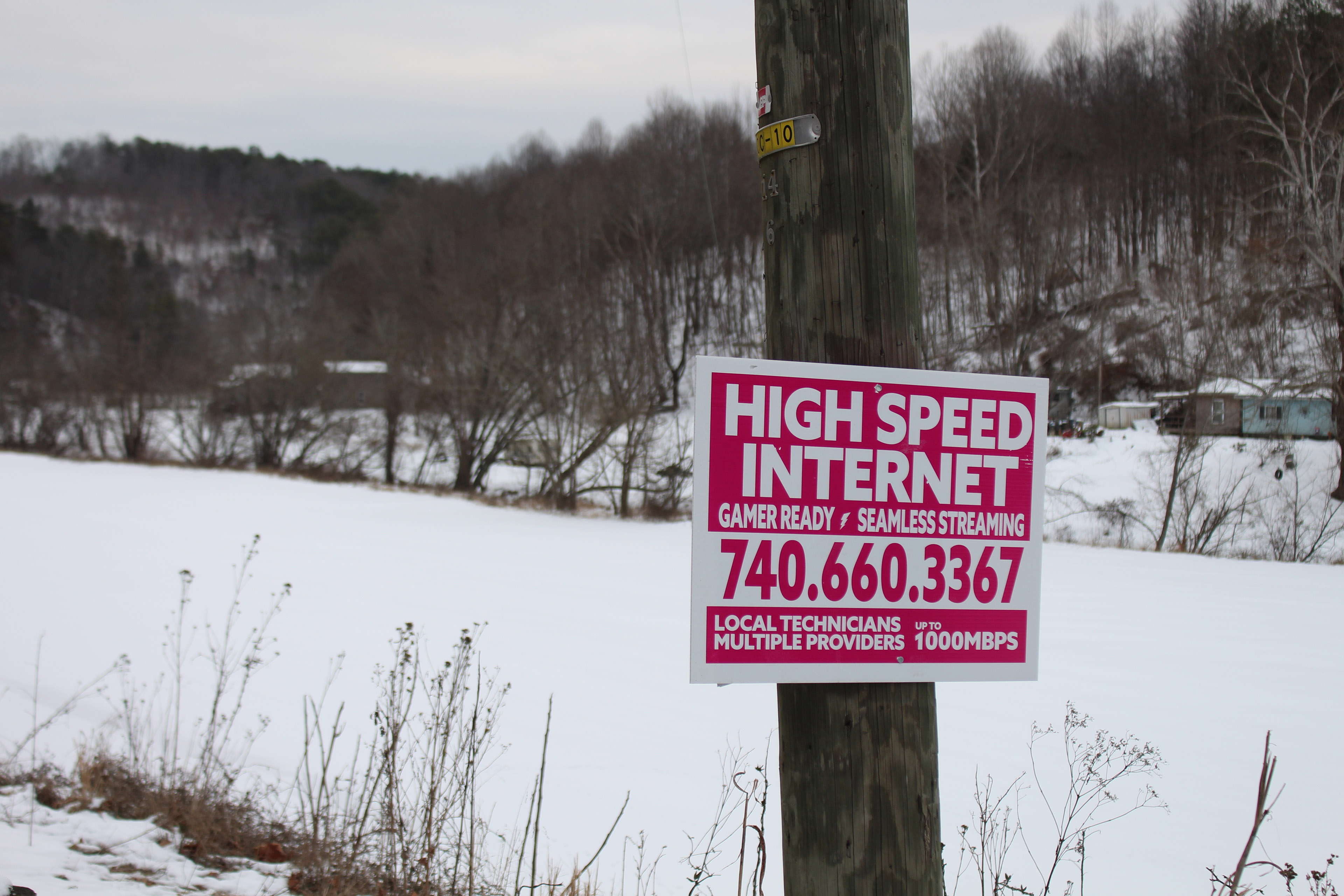Flawed Federal Programs Maroon Rural Americans in Telehealth Blackouts

BRANCHLAND, W.Va. — Ada Carol Adkins lives with her two dogs in a trailer tucked into the timbers off Upper Mud River Road.
“I’m comfortable here, but I’m having health issues,” said the 68-year-old, who retired from her job as a school cook several years ago after having a stroke. “Things are failing me.”
Her trailer sits halfway up a ridge miles from town and the local health clinic. Her phone and internet are “wacky sometimes,” she said. Adkins — who is fiercely independent and calls herself a “Mountain Momma” — worries she won’t be able to call for help if service goes out, which happens often.
To Frontier Communications, the telecommunications company that owns the line to her home, Adkins says: “Please come and hook me right.”
But she might be waiting years for better service, frustrated by her internet provider and left behind by troubled federal grant programs.
A quarter of West Virginia counties — including Lincoln, where the Mud River bends its way through hollows and past cattle farms — face two barriers to health care: They lack high-speed internet and have a shortage of primary care providers and behavioral health specialists, according to a KFF Health News analysis.
Years of Republican and Democratic administrations have tried to fix the nation’s broadband woes, through flawed attempts. Bad mapping, weak standards, and flimsy oversight have left Adkins and nearly 3 million other rural Americans in dead zones — with eroded health care services and where telehealth doesn’t reach.
Blair Levin, a former executive director of the Federal Communications Commission’s National Broadband Plan, called one rural program rollout during the first Trump administration “a disaster.”
It was launched before it was ready, he said, using unreliable federal maps and a reverse-auction process to select internet carriers. Locations went to the lowest bidder, but the agency failed to ensure winners had the knowledge and resources to build networks, said Levin, who is now an equity analyst with New Street Research.
The fund initially announced awards of $9.2 billion to build infrastructure in 49 states. By 2025, $3.3 billion of those awards were in default and, as a result, the program won’t connect 1.9 million homes and businesses, according to a recent study.
A $42 billion Biden-era initiative still may not help Adkins and many others shortchanged by earlier federal broadband grants. The new wave of funding, the Broadband Equity, Access, and Deployment Program, or BEAD, has an anti-waste provision and won’t provide service in places where previous grants were awarded — even if companies haven’t delivered on their commitments.
The use of federal money to get people connected is “really essential” for rural areas, said Ross DeVol, CEO and chairman of the board of Heartland Forward, a nonpartisan think tank based in Bentonville, Arkansas, that specializes in state and local economic development.
“Internet service providers look at the economics of trying to go into some of these communities and there just isn’t enough purchasing power in their minds,” DeVol said, adding that broadband expansion is analogous to rural electrification. Without high-speed internet, “you’re simply at a distinct disadvantage,” he added. “I’ll call it economic discrimination.”
‘I Got Books Full’
Adkins keeps spiral-bound notebooks and calendars filled with handwritten records of phone and internet outages.
In January, while bean soup warmed on the stove, she opened a notebook: “I got books full. Hang on.”

Her finger traced the page as she recounted outages that occurred about once a month last year. Adkins said she lost connectivity twice in November, again in October, and in July, May, and March. Each time she went for days without service.
Adkins pays Frontier Communications $102.13 a month for a “bundle” that includes a connection for her house phone and wireless internet access on her cellphone. Frontier did not respond to requests for comment on Adkins’ and other customers’ service.
Adkins, a widow, spends most of her time at home and said she would do video calls with her doctors if she could. She said she still has numbness on one side of her body after the stroke. She also has high blood pressure and arthritis and uses over-the-counter pain patches when needed, such as after she carries 30-pound dog food bags into the house.
She does not own a four-wheel-drive truck and, for three weeks in January, the snow and ice were so severe she couldn’t leave. “I’m stranded up here,” she said, adding that neighbors check in: “‘Do you have electric? Have you got water? Are you OK?’”
The neighbors have all seen Adkins’ line. The pale-yellow cord was tied off with green plastic ties around a pole outside her trailer. As it ran down the hill, it was knotted around tree trunks and branches, frayed in places, and, finally, collapsed on the ground under gravel, snow, and ice at the bottom of the hill.
Adkins said a deer stepping on the line has interrupted her phone service.

David and Billi Belcher’s double-wide modular home sits near the top of the ridge past Adkins’ home. Inside, an old hunting dog sleeps on the floor. Belcher pointed out a window toward where he said Frontier’s cable has remained unrepaired for years: “It’s laying on the ground in the woods,” he said.
Frontier is West Virginia’s legacy carrier, controlling most of the state’s old landlines since buying them from Verizon Communications in 2010. Twelve years later, the company won nearly $248 million to install high-speed internet to West Virginia through the Rural Digital Opportunity Fund, an initiative launched during President Donald Trump’s first term.
“Big Daddy,” as local transit driver Bruce Perry called Trump, is popular with the people of Lincoln County. About 80% of the county’s voters picked the Republican in the last election.
The Trump administration awarded Frontier money to build high-speed internet to Upper Mud River Road residents, like Adkins, according to state mapping. Frontier has until Dec. 31, 2028, to build.
But the Belchers needed better internet access for work and could afford to pay $700 for a Starlink satellite internet kit and insurance, they said. Their monthly Starlink bill is $120 — a price many cannot manage, especially since Congress sunset an earlier program that helped offset the cost of high-speed plans for consumers.
Meanwhile, the latest broadband program to connect rural Americans is ensnared in Trump administration policy shifts.
The National Telecommunications and Information Administration, which administers the program, in April announced a 90-day extension for states to finalize their plans during a “comprehensive review” of the program.
West Viriginia Gov. Patrick Morrisey, a Republican, announced his state would take an extension. The move, though, doesn’t make a lot of sense, said Evan Feinman, who left the agency in March after directing the broadband program for the past three years.
Calling the work already done in West Virginia an “incredible triumph,” Feinman said the state had completed the planning, mapping, and the initial selection of companies. The plan that was in place would have brought high-speed fiber lines to homes ahead of schedule and under budget, he said.
“They could be building today, and it’s just deeply disappointing that they’re not,” Feinman said.
When Feinman resigned in March, he sent a lengthy email stating that the new administration wants to take fiber away from homes and businesses and substitute it with satellite connections. The move, he said, would be more expensive for consumers and hurt rural and small-town America.
Morrisey, whose office declined to respond to requests for comment, said in his announcement that he wants to ensure West Virginia spends the money in a manner “consistent with program changes being proposed by the Trump Administration” and “evaluate a broader range of technology options.”
Commissioners from Grant County responded with a letter supporting fiber-optic cables rather than satellite-based connections like those provided by Elon Musk’s Starlink. Nationwide, 115 lawmakers from 28 states sent a letter to federal leaders stating that changes could “delay broadband deployment by a year or more.”
For Adkins and others, the wait has been long enough.
While legislators in Washington and across the country bickered over the broadband program, Adkins went without phone and internet. By late March, she said, her 42-year-old son was increasingly worried, noting “you’re getting up in age.” He told her: “Mom, move out, get off of that hill.”
Worst-Case Scenario
A few miles from Upper Mud River Road, past the McDonald’s and across the road from the local library, Brian Vance sat in his downtown Hamlin, West Virginia, office. He said his company has been trying to “build up there for a while.”
Vance is a general manager for Armstrong Telephone and Cable, a regional telecommunications provider that competes with Frontier. He grew up in the community, and parents of a high school friend live off Upper Mud River. But he said “it’s very difficult” to build fiber along the rocky terrain to homes where “you are hoping that people will hook up, and if they don’t, well, you’ve lost a lot of money.”
A 2022 countywide broadband assessment found that stringing fiber-optic lines along telephone poles would cost more than $5,000 per connection in some areas — work that would need big federal subsidies to be feasible.
Yet Vance said Armstrong cannot apply for the latest BEAD funding to help finance connections. And while he likes that the federal government is “being responsible” by not handing out two federal grants for the same area, Vance said, “we want to see people deliver on the grants they have.”
If Frontier hadn’t already gotten federal funds from the earlier Trump program, “we definitely would have applied to that area,” Vance said.
The 2022 assessment noted the community’s economy would not be sustainable without “ubiquitous broadband.”
High-speed internet brings more jobs and less poverty, said Claudia Persico, an associate professor at American University. Persico, who is also a research associate with the National Bureau of Economic Research, co-authored a recent paper that found increased broadband internet leads to a reduction in the number of suicides as well as improvements in self-reported mental and physical health.
More than 30% of Lincoln County’s population reports cases of depression, according to data from the Centers for Disease Control and Prevention. The rate of opioid prescriptions dispensed in Lincoln County is down about 60% from 2014 to 2024 — but still higher than the state average, according to the West Virginia Board of Pharmacy.
Twenty percent of the county’s population lives below the poverty line, and residents are also more likely than the national average to experience heart disease, diabetes, and obesity.
Lincoln Primary Care Center offers telehealth services such as electronic medical records on a patient portal and a pharmacy app, said Jill Adkins, chief quality and risk officer at Southern West Virginia Health System, which operates the clinic.
But because of limited access, only about 7% of patients use telehealth, she said.
Della Vance was a patient at the clinic but said she has never used a patient portal. If she could, Vance said, she would check records on the baby she is expecting.
“You can’t really get on if you don’t have good service and no internet,” she said. “It makes me angry, honestly.”
Vance and her husband, Isaiah, live off a gravel road that veers from Upper Mud River. There is a tall pole with black wires dangling across the road from their small home. Pointing to the cables, Isaiah Vance said he couldn’t get phone service anymore.

Verizon announced plans last year to buy Frontier for an estimated $20 billion. The deal, which must be approved by federal and state regulators, is expected to be completed in early 2026, according to an investor’s press release.
In its federal merger application, Frontier stated that it had taken on too much debt after emerging from bankruptcy and that debt would make it difficult to finish the work of installing fiber to customers in 25 states.
In West Virginia, Frontier’s Allison Ellis wrote in March 3 testimony, seeking approval for the merger from state regulators, that Verizon will honor the rural program commitments. The previous month, in February, Frontier filed a motion with the state public service commission to keep the number of customers using copper lines and the faster fiber-optic lines confidential.
Kelly Workman, West Virginia’s broadband director, said during a November interview that her office has asked federal regulators for “greater visibility” into Frontier’s rural program construction, particularly because those locations cannot win the Biden-era infrastructure money when it's available.
“The worst-case scenario would be for any of these locations to be left behind,” Workman said.
‘Money Cow’
Frontier’s progress installing fiber-optic lines and its unreliable service have frustrated West Virginians for years. In a 2020 letter to the FCC, U.S. Sen. Shelley Capito (R-W.Va.) cited “the failure of Frontier to deliver on promises to federal partners” and its “mismanagement” of federal dollars, which forced the state to pay back $4.7 million because of improper use and missed deadlines.
Michael Holstine, a longtime member of the West Virginia Broadband Enhancement Council, said the company has “just used West Virginia as a money cow.” Holstine has been fighting for the construction of fiber-optic lines in Pocahontas County for years. “I really just hope I get it before I die.”
Across the state, people like Holstine and Adkins are eager for updated networks, according to interviews as well as letters released under a public records request.
Chrissy Murray, vice president of Frontier’s external communications, acknowledged that the company was “building back our community efforts” in West Virginia after a bankruptcy filing and reorganization. She said there has been a “notable decline” in consumer complaints, though she did not provide specific numbers.

Murray said Frontier built fiber-optic cables to 20% of its designated rural funds locations as of the end of 2024. It has also invested in other infrastructure projects across the state, she said in a January email, adding that the company donated high-speed fiber internet to West Virginia University’s rural Jackson’s Mill campus.
According to data tracked by a federal agency, Frontier has connected 6,100 — or fewer than 10% — of the more than 79,000 locations it was awarded in the Rural Digital Opportunity Fund program.
The FCC oversees the rural fund. The agency did not respond to a request for comment. Frontier expects to receive $37 million annually from the agency through 2032, according to a federal filing.
In April, a new batch of letters from West Virginia residents filed as “support” for Frontier’s merger with Verizon appeared in the state regulatory docket:
“My support for this case depends on whether Verizon plans to upgrade or replace the existing Frontier infrastructure,” wrote one customer in Summers County, in the far southern corner of the state, adding, “West Virginians in my neck of the woods have been held hostage by Frontier for a generation now because no other providers exist.”
A customer from Hardy County, in the state’s northeastern corner, wrote: “This is [a] move by frontier to to [sic] escape its responsibility to continue services.”
‘Deep-Rooted’
Adkins moved to Upper Mud River with her husband, Bobby, decades ago.
For years, Bobby and Ada Carol Adkins ran a “carry-out” on Upper Mud River Road. The old building is still at the rock quarry just down the hill and around the curve from where her trailer sits.
It was the type of store where locals kept a tab — which Bobby treated too much like a “charity,” Adkins said. They sold cigarettes, beer, bread, bags of chips, and some food items like potatoes and rice. “Whatever the community would want,” she said.
Then, Bobby Adkins’ “health started deteriorating and money got tighter,” Adkins said. He died at 62 years old.
Now, Adkins said, “I’m having kidney problems. I got arthritis, they’re treating me for high blood pressure.”
Her doctor has begun sending notes over the internet to refill her blood pressure medicine and, Adkins said, “I love that!”
But Adkins’ internet was out again in early April, and she can’t afford Starlink like her neighbors. Even as Adkins said she is “deep-rooted,” her son’s request is on her mind.
“I’m having health problems,” Adkins said. “He makes a lot of sense.”

kffhealthnews





